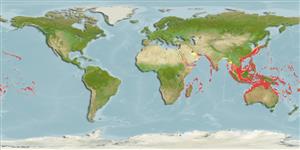Actinopterygii (ray-finned fishes) >
Perciformes (Perch-likes) >
Scombridae (Mackerels, tunas, bonitos) > Scombrinae
Etymology: Euthynnus: Greek, eu = good + Greek, thynnos = tunna (Ref. 45335).
Environment / Climate / Range
Ecology
Marine; pelagic-neritic; oceanodromous (Ref. 51243); depth range 0 - 200 m (Ref. 54439). Tropical; 18°C - 29°C (Ref. 168), preferred 28°C (Ref. 107945); 35°N - 38°S, 32°E - 137°W (Ref. 54439)
Indo-West Pacific: in warm waters including oceanic islands and archipelagos. A few stray specimens have been collected in the Eastern Central Pacific. Highly migratory species, Annex I of the 1982 Convention on the Law of the Sea (Ref. 26139).
Length at first maturity / Size / Weight / Age
Maturity: Lm ?, range 40 - 65 cm
Max length : 100.0 cm FL male/unsexed; (Ref. 168); common length : 60.0 cm FL male/unsexed; (Ref. 168); max. published weight: 14.0 kg (Ref. 30874)
Dorsal
spines
(total): 10 - 15;
Dorsal
soft rays
(total): 11-15;
Anal
spines: 0;
Anal
soft rays: 11 - 15;
Vertebrae: 39. Swim bladder absent. No trace of vertebral protuberances. Anterior spines of first dorsal fin much higher than those mid-way. Interpelvic process small and bifid. Body naked except for corselet and lateral line. Posterior portion of the back with a pattern of broken oblique stripes.
Occurs in open waters but always remains close to the shoreline. The young may enter bays and harbors. Forms multi-species schools by size with other scombrid species comprising from 100 to over 5,000 individuals. A highly opportunistic predator feeding indiscriminately on small fishes, especially on clupeoids and atherinids; also on squids, crustaceans and zooplankton (Ref. 9684). Generally marketed canned and frozen; also utilized dried, salted, smoked (Ref. 9684) and fresh (Ref. 9987).
Collette, B.B. and C.E. Nauen, 1983. FAO Species Catalogue. Vol. 2. Scombrids of the world. An annotated and illustrated catalogue of tunas, mackerels, bonitos and related species known to date. Rome: FAO. FAO Fish. Synop. 125(2):137 p. (Ref. 168)
IUCN Red List Status (Ref. 115185)
CITES (Ref. 94142)
Not Evaluated
Threat to humans
Reports of ciguatera poisoning (Ref. 30911)
Human uses
Fisheries: highly commercial; gamefish: yes
Tools
Special reports
Download XML
Internet sources
Estimates of some properties based on models
Phylogenetic diversity index (Ref.
82805): PD
50 = 0.6250 [Uniqueness, from 0.5 = low to 2.0 = high].
Bayesian length-weight: a=0.00912 (0.00489 - 0.01700), b=3.12 (2.97 - 3.27), in cm Total Length, based on LWR estimates for this species & (Sub)family-body (Ref.
93245).
Trophic Level (Ref.
69278): 4.5 ±0.0 se; Based on diet studies.
Resilience (Ref.
69278): Medium, minimum population doubling time 1.4 - 4.4 years (K=0.4-0.5; tm=3; Fec=210,000).
Prior r = 0.58, 2 SD range = 0.35 - 0.97, log(r) = -0.54, SD log(r) = 0.25, Based on: 1 K, 1 tgen, 2 Fec records
Vulnerability (Ref.
59153): Moderate vulnerability (37 of 100) .
